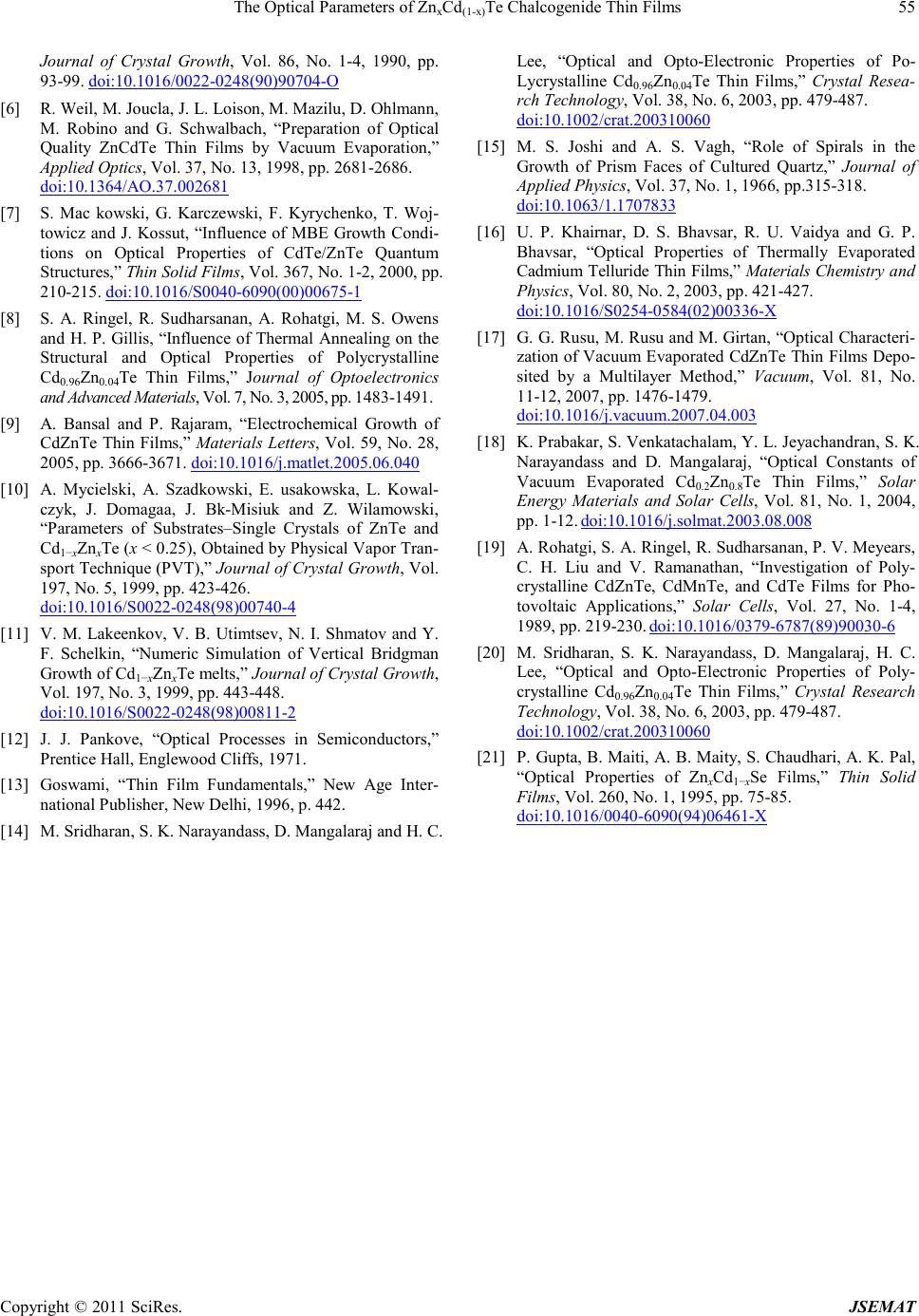
The Opti cal Parameters of ZnxCd(1-x)Te Chalcogenide Thin Films
Copyright © 2011 SciRes. JSEMAT
Journal of Crystal Growth, Vol. 86, No. 1-4, 1990, pp.
93-99. doi:10.1016/0022-0248(90)90704-O
[6] R. Weil, M. Joucla, J. L. Loison, M. Mazilu, D. Ohlmann,
M. Robino and G. Schwalbach, “Preparation of Optical
Quality ZnCdTe Thin Films by Vacuum Evaporation,”
Applied Optics, Vol. 37, No. 13, 1998, pp. 2681-2686.
doi:10.1364/AO.37.002681
[7] S. Mac kowski, G. Karczewski, F. Kyrychenko, T. Woj-
towicz and J. Kossut, “Influence of MBE Growth Condi-
tions on Optical Properties of CdTe/ZnTe Quantum
Structures,” Thin Solid Films, Vol. 367, N o . 1 -2, 2000, pp.
210-215. doi:10.1016/S0040-6090(00)00675-1
[8] S. A. Ringel, R. Sudharsanan, A. Rohatgi, M. S. Owens
and H. P. Gillis, “Influence of Thermal Annealing on the
Structural and Optical Properties of Polycrystalline
Cd0.96Zn 0. 04Te Thin Films,” Journal of Optoelectronics
and Advanced Materials, Vol. 7, No. 3, 2005, pp. 1483-1491.
[9] A. Bansal and P. Rajaram, “Electrochemical Gr owth of
CdZnTe Thin Films,” Materials Letters, Vo l. 59, No. 28,
2005, pp . 3666-3671. doi:10.1016/j.matlet.2005.06.040
[10] A. Mycielski, A. Szadkowski, E. usakowska, L. Kowal-
czyk, J. Domagaa, J. Bk-Misiuk and Z. Wilamowski,
“Parameters of Sub s trates–Single Crystals of ZnTe and
Cd1−xZnxTe (x < 0.25), Obtained by P hysical V apor Tran-
sport Technique (PVT),” Journal o f Crystal Gro wth, Vo l.
197, No. 5, 1999, pp. 423-426.
doi:10.1016/S0022-0248(98)00740-4
[11] V. M. Lakeenkov, V. B. Utimtsev, N. I. Shmatov and Y.
F. Schelkin, “Numeric Simulation of Ver tical Bridgman
Growt h o f Cd 1−xZnxTe melts,” Journal of Crystal Growth,
Vol. 197, No. 3, 1999, pp. 443 -448.
doi:10.1016/S0022-0248(98)00811-2
[12] J. J. Pankove, “Optical Processes in Semiconductors,”
Prent ice Hall, Englewood Cliffs, 1971.
[13] Goswami, “Thin Film Fundamentals,” New Age Inter-
national Publisher, New Delhi, 1996, p. 442.
[14] M. Sridharan, S. K. Narayandass, D. Mangalaraj and H. C.
Lee, “Optical and Op t o-Electronic Properties of Po-
Lycrystalline Cd0.96Zn0.04Te Thin Films,” Crystal Resea-
rch Technology, Vol. 38, N o. 6, 2003, pp. 479-487.
doi:10.1002/crat.200310060
[15] M. S. Joshi and A. S. Vagh, “Role of Spirals in the
Growth of Prism Faces of Cultured Quartz,” Journal of
Applied Physics, Vol. 37, No. 1, 1966, pp.315-318.
doi:10.1063/1.1707833
[16] U. P. Khairnar, D. S. Bhavsar, R. U. Vaidya and G. P.
Bhavsar, “Optical Properties of Thermally Evaporated
Cadmium Telluride Thin Films,” Mat erials Ch emistry and
Physics, Vol. 80, No. 2, 2003, pp. 421-427.
doi:10.1016/S0254-0584(02)00336-X
[17] G. G. Rusu, M. Rusu and M. Girtan, “Optical Characteri-
zation of Vacuum Evaporated CdZnTe Thin Films Depo-
sited by a Multilayer Method,” Vacuum, Vol. 81, No.
11-12, 2007, pp. 1476-1479.
doi:10.1016/j.vacuum.2007.04.003
[18] K. Prabakar, S. Ven katachala m, Y. L. Jeyach andran , S. K.
Narayandass and D. Mangalaraj, “Op tical Constants of
Vacuum Evaporated Cd0.2Zn 0.8Te Thin Films,” Solar
Energy Materials and Solar Cells, Vol. 81, No. 1, 2004,
pp. 1-12. doi:10.1016/j.solmat.2003.08.008
[19] A. Rohatgi, S. A. Rin gel, R. Su dharsanan , P. V. M eyears,
C. H. Liu and V. Ramanathan, “Investigation of Poly-
crystalline CdZnTe, CdMnTe, and CdTe Films for Pho-
tovoltaic Applications,” Solar Cells, Vol. 27, No. 1-4,
1989, pp . 219-230. doi:10.1016/0379-6787(89)90030-6
[20] M. Sridharan, S. K. Narayandass, D. Mangalaraj, H. C.
Lee, “Optical and Opto-Electronic Properties of Poly-
crystalline Cd0.96Zn0.04Te Thin Films,” Crystal Research
Technology, Vol. 38, No. 6, 2003, p p. 479-487.
doi:10.1002/crat.200310060
[21] P. Gupta, B. Maiti, A. B. Mai ty, S. Chaudhari, A. K. Pal,
“Optical Properties of ZnxCd 1−xSe Films,” Thin Solid
Films, Vol. 260, N o. 1, 1995, pp. 75-85.
doi:10.1016/0040-6090(94)06461-X